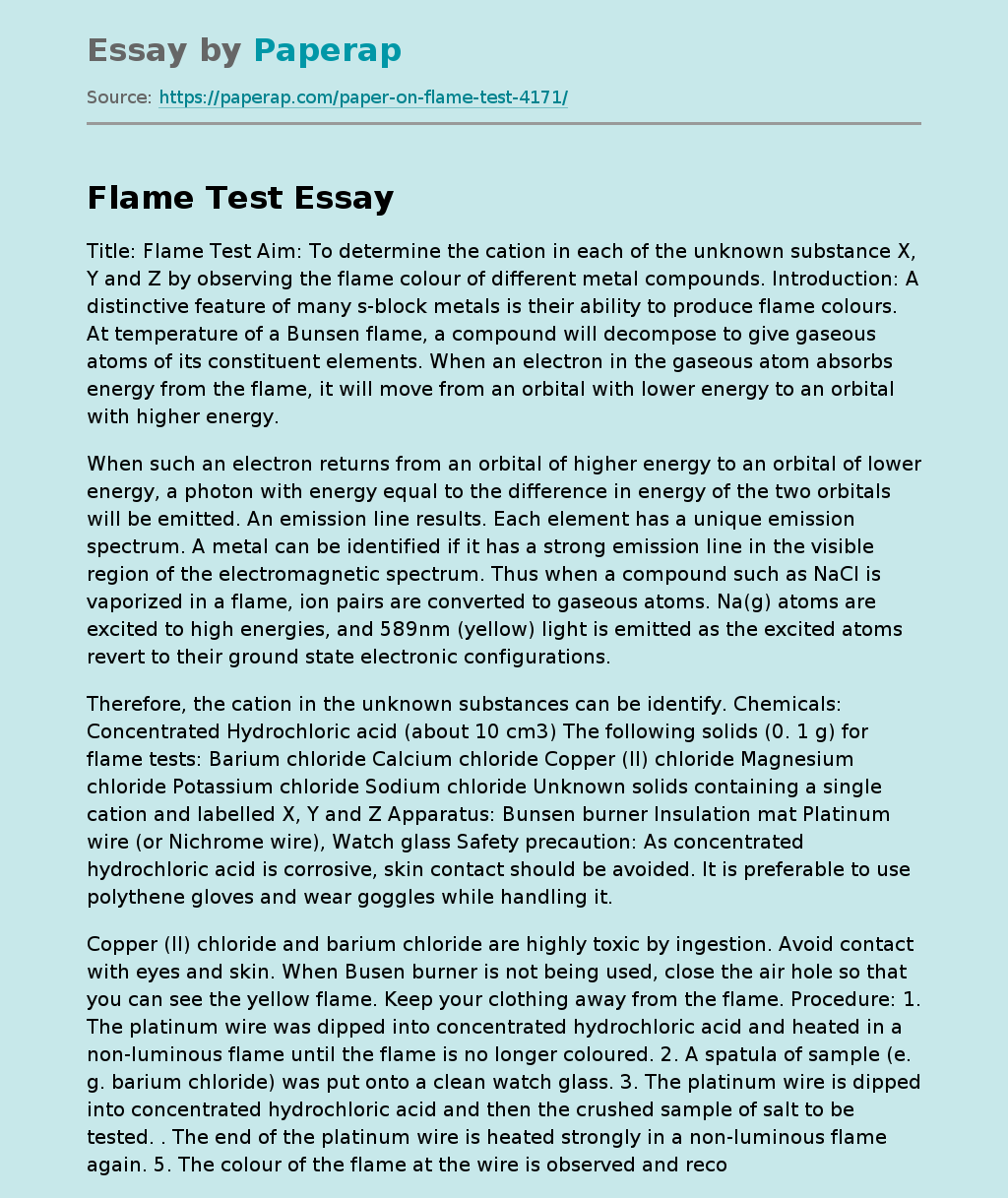Title: Flame Test Aim: To determine the cation in each of the unknown substance X, Y and Z by observing the flame colour of different metal compounds. Introduction: A distinctive feature of many s-block metals is their ability to produce flame colours. At temperature of a Bunsen flame, a compound will decompose to give gaseous atoms of its constituent elements. When an electron in the gaseous atom absorbs energy from the flame, it will move from an orbital with lower energy to an orbital with higher energy.
When such an electron returns from an orbital of higher energy to an orbital of lower energy, a photon with energy equal to the difference in energy of the two orbitals will be emitted. An emission line results. Each element has a unique emission spectrum. A metal can be identified if it has a strong emission line in the visible region of the electromagnetic spectrum. Thus when a compound such as NaCl is vaporized in a flame, ion pairs are converted to gaseous atoms.
Na(g) atoms are excited to high energies, and 589nm (yellow) light is emitted as the excited atoms revert to their ground state electronic configurations.
Therefore, the cation in the unknown substances can be identify. Chemicals: Concentrated Hydrochloric acid (about 10 cm3) The following solids (0. 1 g) for flame tests: Barium chloride Calcium chloride Copper (II) chloride Magnesium chloride Potassium chloride Sodium chloride Unknown solids containing a single cation and labelled X, Y and Z Apparatus: Bunsen burner Insulation mat Platinum wire (or Nichrome wire), Watch glass Safety precaution: As concentrated hydrochloric acid is corrosive, skin contact should be avoided.
It is preferable to use polythene gloves and wear goggles while handling it.
Copper (II) chloride and barium chloride are highly toxic by ingestion. Avoid contact with eyes and skin. When Busen burner is not being used, close the air hole so that you can see the yellow flame. Keep your clothing away from the flame. Procedure: 1. The platinum wire was dipped into concentrated hydrochloric acid and heated in a non-luminous flame until the flame is no longer coloured. 2. A spatula of sample (e. g. barium chloride) was put onto a clean watch glass. 3. The platinum wire is dipped into concentrated hydrochloric acid and then the crushed sample of salt to be tested. . The end of the platinum wire is heated strongly in a non-luminous flame again. 5. The colour of the flame at the wire is observed and recorded. 6. The platinum wire is cleaned thoroughly after testing each solid. The test is repeated with chloride of Ca2+, Cu2+, Mg2+, K+, Na+ and unknown solid X, Y and Z in turn. Results: Compound| Colour of the flame| Cation Presents| Barium chloride| Apple green| | Calcium chloride| Brick red| | Copper(II) chloride| Bluish green| | Magnesium chloride| White| | Potassium chloride| Lilac| | Sodium chloride| Golden yellow| | X| Lilac| K+|
Y| Bluish green| Cu2+| Z| Golden yellow| Na+| Discussion: 1. Why do certain metal ions give flame colours in this way? The elements have their outer electrons loosely bound so that they can be easily excited to higher energy levels on heating. As these electrons return to their ground states, radiations are emitted. It happens that for many Group I and II metals, these emitted radiations fall into the visible range of the spectrum, so that they can be seen by eyes, i. e. , visible. 2. What is the function of concentrated hydrochloric acid? It is used to clean the platinum wire.
The concentrated hydrochloric acid converts ant contaminated salts to their corresponding chlorides, which are usually more volatile to be vaporized off. It gives better observations as the boiling point of metal chloride is lower and less heat is needed to vaporize it. Besides, the sample of powdered compound whose flame colour is to determined is easier to stuck on the platinum wire. 3. Substance A gives a golden yellow flame in flame test. When an acidified solution of A is treated with silver nitrate solution, a yellow precipitate is formed. The precipitate is insoluble in excess ammonia solution. Name A. Substance A is sodium iodide.
Limitation The range of detected elements is small, and the test relies on the subjective experience of the experimenter rather than any objective measurements. The test has difficulty detecting small concentrations of some elements, while too strong a result may be produced for certain others, which tends to drown out weaker signals. Moreover, the test cannot differentiate between all elements. Several metals produce the same flame color while some compounds do not change the color of the flame at all. Source of error The source of error of the experiment include the subjective judgment of the colour by the human eye.
Besides, the traces of Impurities from the last substance tested and the position of the wire put in the flame also affect the accuracy of the experiment. Improvement The wire should be moved first through the cooler part of the non-luminous Bunsen flame by approaching from underneath, so that even very volatile substances could colour the flame long enough to be observable. The platinum wire should be cleaned thoroughly before testing for a new compound as impurities or contaminants affect the test results. Conclusion: The cation in the unknown substance X, Y and Z is K+, Cu2+ and Na+ respectively.
Cation Identification by Flame Test. (2018, Jan 03). Retrieved from https://paperap.com/paper-on-flame-test-4171/

